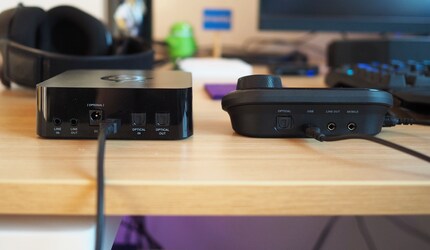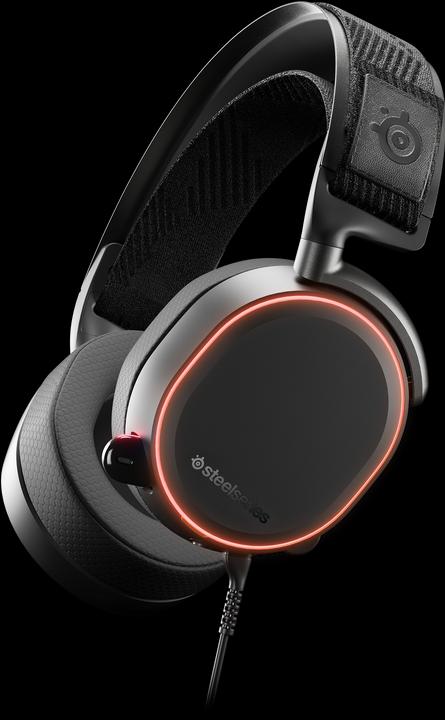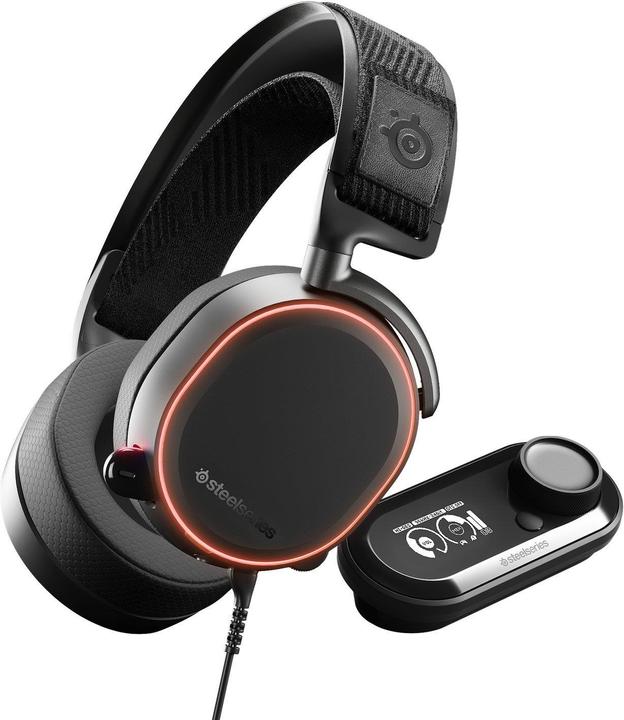

Arctis Pro: the new benchmark in gaming headsets?
The three new gaming headsets from Steelseries want to play in the big league. One version is equipped with an analogue-to-digital converter certified for Hi-Res sound. Gamers won't really benefit from this, but the Arctis Pro are convincing all the same.
What's the point of having state-of-the-art graphics, if the sound sucks? Every gamer worth their salt should have a good headset for playing online games, especially if they want to hear their mum complaining in the background. I picked up the Arctis Pro series wireless and GameDAC models and opened my ears wide.
A festival of features
The wireless and GameDAC versions are only compatible with a PS4 and PC. By contrast, the cheapest model can be used on an Xbox One and Nintendo Switch. The box contains a USD cable, a 3.5mm adaptor for your smartphone, a pop filter and a Toslink connector for the PS4. If you have a Slim, you'll need to use a receiver or TV. If you don't connect your headset to your PS4 with a Toslink connector, you'll have to do without surround sound. On your PC, a USB connection will suffice. A Toslink connector won't do you any good. What's more, the Windows volume control is disabled by GameDAC. It's a shame that the GameDAC's sockets and remote control are proprietary. Steelseries no doubt opted for this so that the wireless model wouldn't be confusing, since it charges with another (micro) USB cable.

The microphone can't be removed, but you can simply stow it inside the headset and mute it using a button on the earcups. An annoying red light then tells you that it has been deactivated. Fortunately, you can turn it off if it bothers you.

The wheel on the left earpiece is used to adjust the volume. On the wireless model, you can also click it to scroll through the various features on the screen. This solution isn't very practical for me: since I'm a few metres away from the receiver, I can't read the screen. And I don't know the menu by heart. But you'll usually only have to change the chatmix (the mix of game sounds and chat sounds) with one click.

The wireless version is also equipped with a Power button as well as a Bluetooth button. In fact, as well as operating the headphones using WiFi, you can connect them to a smartphone via Bluetooth. I also like the automatic switch-off function. You can set the switch-off time in the Steelseries software.
The wireless headset comes with two batteries. You place one under the removable cover of the right earpiece while you recharge the other by plugging it into the base station. The batteries in all models are interchangeable. The 10-hour battery life quoted by Steelseries is fair enough.

The GameDAC's remote control or the wireless headset's base station allow you to set the equaliser, change the source (PC, PS4 or Hi-Res), or activate DTS or chatmix, among other things. The latter is very practical, as it adjusts the balance between the game sound and the chat sound. I find it really great on 'PUBG' when I want to hear my mates' nonsense over the roar of planes or vehicles. Almost all the options are configurable on the Steelseries software.

The cable configuration between the GameDAC and the PS4 has been rather poorly thought out. The cables are far too short to use the headset from your sofa. You'll need to get yourself a USB extension cable or opt for the wireless version, with which you unfortunately can't (at least on the PS4 Pro) switch easily between speakers and headphones, and vice versa. With my Astro A50, I can adjust the PS4's audio settings to switch between optical out and HDMI out. That's not important for the Arctis. All I have to do is remove the USB cable and the sound comes through my surround system again.
Wearing comfort and sound loss
The Arctis Pro aren't great for large heads. The metal hoop can be adjusted slightly with a strip of cloth, but I'm used to the looser Astro A50. I don't feel any pain, though, even after wearing my Arctis Pro for several hours. The thick padding makes it really comfortable, even if it gets really hot when the thermometer climbs. I didn't find wearing it around my neck very comfortable. The cables don't go so far as to strangle me, but they're still quite tight.

Thanks to their good fit and padding, sound loss remains minimal. That's handy when you're on the move. Personally, I prefer more permeable headphones at home or during LAN parties.
Both cable-connected models have RGB lighting that you can adjust with the Steelseries Engine software or sync with other Steelseries products.
Sound quality
All three Arctis Pros have the same 40mm drivers with 10,000-40,000Hz frequency response, 32-ohm impedance and 102dB headphone sensitivity. That sounds pretty good in theory, compared with other headset microphones. But the maximum volume is a little low. You can't really turn it up. When I'm playing really loud like in PUBG, I have a bit of trouble hearing other players. The only solution is to set the software's Gain setting to "high", but then you hear a slight background noise during silent scenes.

Aside from the minor flaws I've just mentioned, the sound quality is impeccable. Compared to the Arctis 3 or my Astro A50, the sound is voluminous, powerful and very clear. Brutal games like 'Battlefield 1' or 'Overwatch' bear witness to this. Details are clearly perceptible; when it rumbles, it really rumbles. The analogue-to-digital converter is equipped with an ESS Sabre chip, which may make it even more powerful than the wireless version, but I could be wrong. I was pleasantly surprised by the sound of both versions.
The GameDAC is also capable of playing high-resolution audio files. While all three headphones support Hi-Res audio, only the GameDAC is certified. This means it can play files at up to 96kHz and 24-bit, while the Arctis wireless can play "only" 16-bit at 44.1kHz. While Hi-Res is not detrimental to GameDAC, it does not represent a real standard. Rather, it's a marketing concept that Sony likes to push.

Unlike music, video games are not affected by Hi-Res. I tested Tidal for free for a month and listened to its small Master Collection. Only songs with a capital 'M' are played at the best possible quality. Led Zeppelin's Kashmir, Mozart's violin concerto in D major KV 218, Gorillaz's Feel Good Inc., Deftones' My Own Summer (maybe not the most representative track, but it's still great)... I've listened to lots of different styles. Everything sounds great with the Arctis Pro GameDAC (I'd have liked to have turned it up, but hey...). I then did a blindtest with my wife. I played the songs once in Hi-Fi (44.1 kHz/16 bit) and once in master quality, and switched back and forth between the two. Most of the time, my wife identified the correct version. I got it wrong more often. We both concluded that you really need a keen ear to perceive the difference in quality.
A cool thing happens when you try to perceive the slightest differences in quality: you listen to the music much more carefully. I think that's a pleasure that's far too rare and far too underrated these days.
I haven't really managed to get used to the DTS:X 2.0 virtual surround sound feature. You can turn it on or off at any time by pressing a button. On the wireless version, it's called 'Surround Sound' and has to be selected from the menu. In the worst cases, as in 'PUBG', I felt like I was in a gym. In the best cases, the surround slightly smoothed out the transfer of sound from the left earpiece to the right. But in almost all cases, the sound strayed too far from the original. Without DTS:X 2.0, noise is immediately noticeable. Nor do I get the impression that they're happening just a few metres away from my character. On the other hand, the various audio sources are a little more easily differentiated with DTS:X 2.0. Voices, music and noises otherwise tend to blend together a little more.
DTS:X, Dolby Atmos or just 5.1?
I nearly went nuts trying to figure out how to make headphones work. The various audio standards and settings are a nightmare. Take the GameDAC, for example. According to its user manual, you need to set its speaker as the default speaker in Windows, not the headset, which is also on the list. The headset should be set as the default communications device. So far, so good. The GameDAC is recognised by Windows as a 5.1 system. You can't choose anything else. However, this configuration only shows the side speakers. Where are the surround speakers? And shouldn't this be a 7.1 system anyway? Isn't everything virtual?

Then you have to choose between DTS:X and Dolby Atmos. DTS:X is more object-based sound. It is an alternative to Dolby Atmos. Unlike Dolby Digital, sources do not have to be in this audio format. DTS:X mixes 3D sound from stereo or multichannel sources. Based on the metadata, DTS:X knows what kind of environment needs to be simulated in the game, otherwise the sound will sound like a boombox in a dustbin, as is the case in "PUBG". Activating Dolby Atmos on Windows will cost you 15 francs. Once you've bought it, go to Windows audio settings → Headset properties → Enable surround sound. This only works for the wireless version, though. You need to set the GameDAC as the default audio device instead of the speaker. Are you getting confused? Well, so am I. If you understand anything, I'll let you explain it all to me in the comments.

Eight games (in English) already support Dolby Atmos technology. I wasn't able to activate it in "Battlefield 1", and I didn't really notice any difference in "Overwatch".
I opted for the Steelseries presets and gave up on DTS:X.
Call quality
The microphone produces a very clear, but somewhat metallic sound. Most gamers found the voice output very good on Discord. Only one of my friends asked me if I'd caught a cold. Incidentally, you can hear what comes out of my mic in the article about our Battletech party (in German). The Steeleries Clearcast microphone does have noise cancellation, but gamers can still hear you typing on your keyboard if you're using a mechanical keyboard. I only realised this when I activated the function that sends the voice back to the headphones. You can set the volume at which you want to hear yourself. I had to give up the very pleasant sensation of hearing my own voice only very faintly, through the isolation of the headphones. The microphone sends my voice to the headphones without delay. It's a bit disturbing at first, but very pleasant overall. At least you know what noises the other players are hearing ;).

Summary: these headset microphones are worth the splurge, even without Hi-Res
Both headset microphones won me over, with or without cable. The sound quality is exceptional, they're very comfortable to wear, even after long gaming sessions, and they have an impressive number of features. The interchangeable batteries, chatmix and Steelseries Engine remote control show no signs of weakness. The GameDAC is my first choice on the PC. It sounds a bit better and it complements my RGB setup. I may not be a luminary, but I know how to enlighten my lantern... ;) On the other hand, I find Hi-Res superfluous. Those who notice the difference won't be buying a gaming headset anyway. If you play on the PS4, I'd advise you to choose the wireless version. The GameDAC cables are far too short. With its Pro series, Steelseries offers us top-of-the-range headsets that are worth their price.
Being the game and gadget geek that I am, working at digitec and Galaxus makes me feel like a kid in a candy shop – but it does take its toll on my wallet. I enjoy tinkering with my PC in Tim Taylor fashion and talking about games on my podcast http://www.onemorelevel.ch. To satisfy my need for speed, I get on my full suspension mountain bike and set out to find some nice trails. My thirst for culture is quenched by deep conversations over a couple of cold ones at the mostly frustrating games of FC Winterthur.




